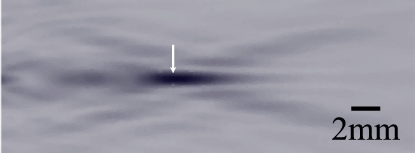home
> products
> BAT's
> BAT
performance > beam profiles
Typical beam profiles of BAT® transducers
The beam profiles (or radiation patterns) of MicroAcoustic BAT® transducers follow closely the predictions of plane-piston theory. This means that the entire active surface of a BAT® transducer moves together as a unit in a direction normal to the radiating surface. As a result, the radiation patterns of BAT® transducers can be accurately modelled for a wide variety of aperture shapes and under a wide variety of applied drive-voltage conditions. This is very unlike the situation with most ultrasound transducers, where additional radial (and other spurious) modes of vibration often complicate radiation patterns beyond the predictions of a simple model.
example 1 - pulsed response of an unfocussed BAT:
The typical radiation pattern for an unfocussed BAT® source under impulsive excitation is shown below. This experimentally-obtained beam profile is that of a standard BAT-1 transducer having a 10mm diameter planar aperture. In this figure, the ultrasonic beam emerges from the transducer at left, focuses slightly within the near-field region below ~30mm, and then exhibits the expected far-field behaviour throughout the Fraunhofer zone.

axial direction =>
Note that at frequencies greater than ~800kHz, attenuation of
ultrasound in air is so high that far-fields typically do not form in such
radiation patterns. This is true of any air-coupled transducer, and means
that: (a) transducers must generally be operated within their near-fields
at higher frequencies; and (b) the effective bandwidth of an
air-coupled transducer decreases with distance away from the transducer
aperture.
example
2 - toneburst
response of a focussed BAT:
One way of
focussing a BAT®
transducer is to employ a
micromachined zone-plate (see BAT-2). The typical radiation pattern
for such a device is shown below when driven by a 700kHz
toneburst voltage. This
experimentally-obtained beam profile plots the highest intensity
as black with the lowest intensities light grey. In this figure, the
ultrasonic beam emerges from the transducer at left and focusses at a
distance of ~ 10mm from the transducer (see white arrow). The beam waist or
focal spot size at the position of the white arrow is less than 800µm
across, which makes such a device useful for high-resolution imaging in
gases. The depth of field (or axial length of the focal region) is approximately
3mm.

axial direction =>
One interesting attribute of using a zone-plate for focussing is the focal distance can be altered in position along axis simply through changes to the frequency of the toneburst used. In the field of optics, such a device is said to "suffer" from chromatic aberration, but in gas-coupled ultrasonics this attribute can be put to great use. MicroAcoustic has studied the performance of such BAT® zone-plate transducers in detail and knows that they follow closely the predictions of plane-piston theory.
www.microacoustic.com